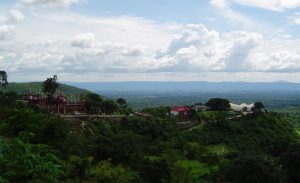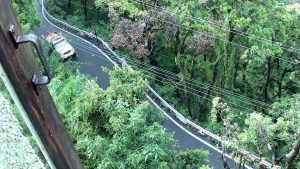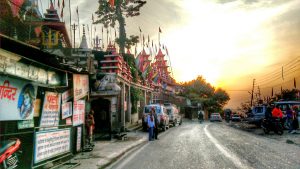This is a unique city, this Dehradun. It was love that dragged me here the first time. That first time, I remember Dehradun being a unique kind of quaint. Everything here, life, food and therefore, love stories, are all connected to the crazy weather here. I do not know of a single scientific term that describes Dehradun weather entirely and accurately. Most people just call it ‘lovely’. It is very common to hear people say that ‘Dehradun weather is lovely’, ‘Dehradun weather is beautiful’.

I have to tell you that you must not misunderstand this term; ‘lovely weather.’
It may lead you to imagine perennial blue skies, pleasant breeze, and beautiful sunshine as default all time Dehradun weather. One would imagine that Dehradun has this standard weather type running throughout the year. This however, is neither entirely true, nor entirely false. It rains a lot, and it is sunny most times, and it gets cold during winter nights, and it may rain during summer and winter and spring, and fall, and may be even an entire summer weekend. It would rain all the more so, when you least expect it and you may therefore, hate it and curse it even.
Therefore, it is difficult to state this accurately. I could say that the standard weather pattern in Dehradun is erratic or I could say that an erratic weather pattern is standard in Dehradun. Either way, it would ultimately boil down to crazy, unpredictable, random weather round the year, that is just so overwhelming and beautiful, that your heart will melt, and you will just want to sit by your window side and look out into the garden and fall in love. In your dreamy head, you would say exactly what all of us in Dehradun have been saying for years, without really knowing the meaning- ‘oh my, what lovely weather’.
This feeling, when I look out of my window when in Dehradun, is a lot like love. One can never entirely own it, or never entirely disown it. I just struggle with it, loving and aching through every bit of it. There is sweet pain, when I can’t touch or hold this feeling. I want to put my love for the rain in a little jar and bottle it, I want to secure it forever. But love and beauty, are both only there for one to experience. Like rain water, it slips through one’s fingers. Even if it is snow or ice, it has to melt become water and slip through one’s fingers.

But I know the truth of the touch of rain. And, only I will really ever know how that touch felt to me, and how that wetness became one with my body. No person, no circumstance, no logic or no reason can extract this experience from my being, from what I have become today, since my first rainy day in Dehradun.
As a child, when I read Yeats or Wordsworth or Emily Dickinson and their poems on nature, I never stopped to understand the yearning that these poets felt that may have compelled them to dedicate a lifetime writing poetry on flowers, and fields and trees and skies. A buttercup, and a daffodil inspired philosophy, science and poetry. The English countryside inspired and continues to inspire fantasy. What is it in the beauty of a flower that wrenches and squeezes the heart, that it emotionally tires out a person compelling him to become a poet or a writer.
I remember an experience from my childhood very vividly that may explain this partially. I was travelling with my father in a train from Kerala to Bombay. At that time, I used to live with my parents in Kerala. I had seen paddy fields and coconut groves and beautiful virgin beaches, and marine blue waters, flowing rivers, thick dense forests and even highlands until then. But I had never seen a sunflower field before. I was sitting next to the window, in a moving train seeing large parts of India pass very fast, flashing in front of my eyes, like a film that was on fast forward. And then suddenly, the whole film became yellow. Large stretches of yellow. India outside the train window was all yellow flowers, large stretches of flower gardens. Sunflowers.

I fell in love with the sunflower fields. All I wanted was for the film to keep going. To not end. For these sunflower fields to keep whisking in front of my eyes continuously. I kept thinking of how to own this weird feeling, probably my first experience of love and lust (who says all love and lust is provoked only by a boy in a girl). I imagined myself running in the sunflower fields. But that did not feel quite right. I would not be able to see the sunflower fields from a distance, the way I was seeing it from the train window. Being in the field would not feel the same. Even if I plucked a few flowers and took them home with me, it would not feel the same. In that moment, I just wanted to eat the whole field up and feel content.
It has been more than 22 years, but when I think of sunflower fields, I just want to eat the whole field up. Today, living in Dehradun, love still feels the same. I have not been able to bottle it and decorate my shelf with my love jar, I have also not been able to eat everything I fell in love with, not Dehradun, not my husband. But I am able to write, a little bit about little things that may have been love in that moment. I am compelled to write because I cannot own or eat all the things that I am in love with. There is a string that connects nature’s beauty to man’s love and that compels him or her to write. This is how love, nature, beauty and all encompassing life ultimately just become literature. And you may, at the end, own a few words printed in a few books forever.
The above is expressed by Nazia Yusuf Izuddin, who is the Chairperson of Dehradun Community Literature Festival (DCLF) to be held from April 19-April 22 in Dehradun. Newsd is a digital media partner for DCLF 2017. A lawyer, Izuddin is also a member of the international fellowship of reconciliation and women peacemakers program, the Netherlands and people’s council for social justice, India.


















